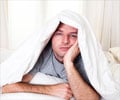Human sleep dynamics in real life could be recorded by making use of longitudinal wrist movement recordings. This device measures inactivity and limb movements.
- Limb movement during sleep shows sleep patterns.
- Non-linear conversion to inactivity reveals rhythms linked to sleep physiology.
- Inactivity oscillates with a 110-min period and gradually declines across the night.
"There has been practically no possibility of getting detailed sleep structures in a normal life setting over a long period of time," says Till Roenneberg of LMU Munich in Germany. "You can't easily give somebody an EEG to take home and have next to the bed. You can't do this over six weeks or six months. We are going to see things nobody has seen before."
Wrist-worn gadget to measure sleep in real-life
The key is a simple, wrist-worn research gadget that can be purchased for as little as $150. They are akin to commercially available self-trackers used by consumers. The gadgets, called actimeters, record data on wrist movement from which one can obtain activity patterns for up to three months. The researchers used the actimeters to assess rest/activity cycles not just over the course of the waking day, but also during sleep itself.
The findings are the latest in a larger, ongoing human sleep project, designed to learn more about sleep and its essential role in our lives by collecting sleep data on thousands of people in the real world. Roenneberg's team had been collecting information on sleep duration and quality via questionnaire. The next step was to find a way to collect objective measurements of sleep characteristics on similarly large numbers of people.
Measuring inactivity cycle during sleep
In the new study, Roenneberg and colleagues, including Eva Winnebeck, looked to actimeter data collected over more than 20,000 days from 574 subjects, aged 8 to 92 years. But the patterns of activity during sleep collected using the devices appeared rather messy. It was hard to discern the cyclical sleep patterns normally seen with other, more complicated devices in the lab.
"It was flabbergasting how it clarified the structures," Roenneberg says.
Roenneberg said that it wasn't clear at first how the inactivity cycles matched up to the patterns of rapid eye movement (REM) and non-REM sleep typically measured in the lab. Further study revealed that periods of least activity reflected deeper sleep. Those of greater activity corresponded to light and REM sleep. That's because, during REM sleep, the extremities frequently twitch and those twitches are detected by the actimeters.
As the researchers collect data in this way on many more people, they hope to come up with new and much more objective ways to measure not just sleep but also sleep quality. Such measures are essential for evaluating whether interventions to improve sleep actually work.
"Right now, we're not able to judge the outcome of interventions," Roenneberg says. "If, for example, we change school times, is sleep quality changed? What about shift work times or indoor lighting? All interventions necessary to improve sleep today are only judged by sleep duration and by asking people how they feel they have slept. There's no objective way to measure sleep quality, and we need this desperately."
Roenneberg says they are now poised to measure and compare sleep of people living in different cultures, climates, latitudes, and lifestyles. They ultimately plan to build online infrastructures to allow anyone to upload actimetry recordings and receive meaningful feedback on their sleep.
"Many devices have tried to use activity to assess sleep structures, but our method is simple, transparent, and works especially in long-term recordings," Roenneberg says. "This will help many who have sleep problems and will hopefully increase the appreciation for the importance of sleep for our health and well-being."
References:
- Eva Charlotte Winnebeck, Dorothee Fischer et al. Dynamics and Ultradian Structure of Human Sleep in Real Life, Current Biology http://dx.doi.org/10.1016/j.cub.2017.11.063
Source-Eurekalert
















